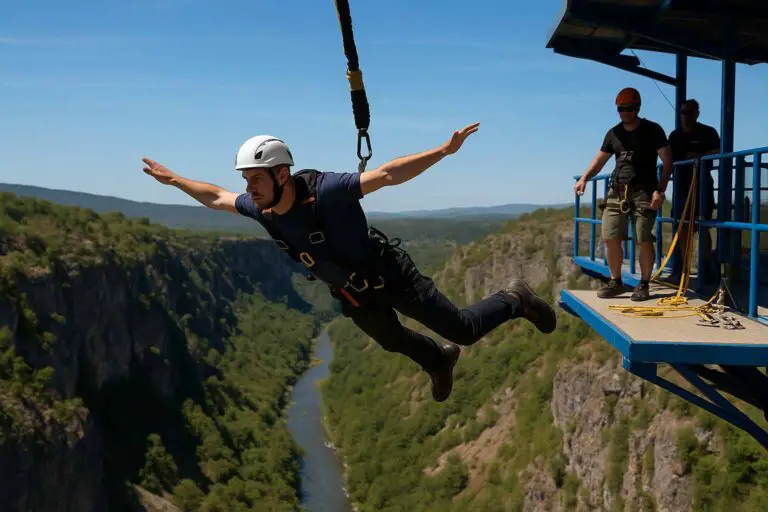Bungee jumping is an exhilarating and adrenaline-pumping adventure that attracts thrill-seekers from around the world. The idea of leaping off a platform with nothing but a bungee cord to stop you from plummeting to the ground is both terrifying and thrilling. However, one question that often arises when considering bungee jumping is whether there is a weight limit.
Yes, there is typically a weight limit for bungee jumping, and it varies among different bungee jumping operators and locations. The general maximum weight for bungee jumping is 320/ 330 ibs and 145/150kg. The weight limit is in place to ensure the safety of participants and the proper functioning of the equipment.
Let’s explore the safety aspects of bungee jumping, dispel common myths, and discuss any potential weight restrictions that might apply.
The Thrill of Bungee Jumping
Bungee jumping is not for the faint of heart. It involves a controlled freefall from a great height, with the jumper attached to a strong and elastic bungee cord. The sensation of falling and the subsequent rebound can be a euphoric rush, making it a popular adventure sport for those seeking an adrenaline fix.
But with great thrill comes great responsibility. Bungee jumping is not without its risks, and operators take various precautions to ensure the safety of participants. One of the safety measures that often comes into question is whether there is a weight limit for bungee jumping.
Safety First: The Physics of Bungee Jumping
Before delving into the weight limit discussion, let’s understand the physics behind bungee jumping. At its core, bungee jumping relies on the principles of elasticity and energy conservation.
When a person jumps off a platform, the bungee cord stretches and absorbs the kinetic energy generated during the fall. As the cord extends, it converts the potential energy of the jumper into elastic potential energy within the cord itself. This stored energy then propels the jumper back upwards, creating the characteristic bounce associated with bungee jumping.
The key factor that determines the safety and feasibility of a bungee jump is the elasticity and strength of the bungee cord. The cord must be able to withstand the force exerted on it during the jump and subsequent rebound without breaking or snapping. Factors like cord material, thickness, and overall length are carefully considered by bungee jumping operators to ensure the cord can safely accommodate the energy generated by a jump.
Weight Limit or Weight Ratio?
When it comes to the weight limit for bungee jumping, it’s essential to clarify that it’s not solely about the individual’s weight but rather the weight ratio between the jumper and the cord. In other words, it’s not the weight itself but how that weight interacts with the elasticity of the bungee cord that matters most.
Bungee jumping operators calculate the ideal cord length and thickness based on the total weight of the jumper and the height of the jump. This calculation ensures that the cord can absorb and release enough energy to provide a safe and controlled jump.
You may be also interested to know how old you have to be to bungee Jump.
The Safety Factors
Several factors come into play when determining the weight limit or weight ratio for bungee jumping:
1. Cord Strength and Elasticity:
The bungee cord must be strong enough to withstand the force generated by the jumper’s fall and rebound. Cord strength is typically rated by the manufacturer, and operators use cords that meet or exceed safety standards.
2. Jump Height:
The height from which the jumper will leap significantly affects the energy generated during the fall. Higher jumps require longer and more elastic cords to ensure a safe rebound.
3. Jumper’s Weight:
While the jumper’s weight itself is a factor, it is not the sole determinant of safety. The combination of the jumper’s weight and the height of the jump must be taken into account to calculate the appropriate cord specifications.
4. Safety Margin:
To account for variations in jump conditions, operators often incorporate a safety margin into their calculations. This margin ensures that even in less-than-ideal scenarios, the bungee cord can still safely handle the jump.
Common Myths About Bungee Jumping and Weight Limits
As with any adventure sport, bungee jumping has its fair share of myths and misconceptions. Let’s take a look at some common myths related to bungee jumping and weight limits:
Myth 1: There is a Universal Weight Limit
One of the most persistent myths is that there is a universal weight limit for bungee jumping that applies to everyone. In reality, weight limits vary between operators and are based on their specific equipment and calculations.
Myth 2: Heavier People Are at Greater Risk
While it’s true that heavier individuals may put more strain on the bungee cord, the safety of a jump is determined by the weight ratio, not the individual’s weight alone. Operators carefully consider the weight-to-cord ratio to ensure safety.
Myth 3: Bungee Jumping Is Only for the Slim
Bungee jumping is not exclusive to individuals of a particular body type. As long as the weight ratio is within the safe range, people of various body sizes and shapes can enjoy bungee jumping.
Myth 4: Operators Don’t Care About Safety
Bungee jumping operators prioritize safety above all else. They conduct rigorous inspections of equipment, regularly maintain their bungee cords, and calculate jump parameters meticulously to ensure a safe experience for participants.
Myth 5: Weight Limit Rules Are Arbitrary
Operators follow industry standards and guidelines when determining weight limits. These standards are in place to prioritize safety and prevent accidents.
The Role of Regulation
In many countries, bungee jumping is regulated by government authorities or industry organizations. These regulations establish safety standards and guidelines that operators must adhere to, including those related to weight limits and equipment maintenance.
Operators must obtain the necessary permits and certifications to operate a bungee jumping business legally. These certifications often require them to meet specific safety criteria, including conducting regular inspections of equipment, maintaining records, and adhering to weight limit calculations.
Personal Responsibility and Health Considerations
While operators play a crucial role in ensuring the safety of bungee jumping, participants also have responsibilities. Here are some personal considerations and health factors to keep in mind before attempting a bungee jump:
1. Disclosure of Medical Conditions:
Participants should disclose any medical conditions or physical limitations to the bungee jumping operator. Certain medical conditions may disqualify individuals from jumping or require special accommodations.
2. Follow Operator Instructions:
Operators provide detailed instructions on how to prepare for a bungee jump. It’s essential to listen carefully and follow these instructions to ensure a safe experience.
3. Weight and Health:
Individuals should consider their overall health, fitness level, and weight before attempting a bungee jump. Being in good physical condition can enhance the safety and enjoyment of the experience.
4. Weight Loss or Gain:
If there are significant changes in an individual’s weight, they should inform the operator. Weight fluctuations can impact the safety calculations and may require adjustments to the bungee cord specifications.
Conclusion: Bungee Jumping is for Everyone, Safely
In conclusion, bungee jumping is an exciting adventure sport that can be enjoyed by people of various body sizes and shapes, as long as safety standards and weight ratios are carefully considered. It’s crucial to debunk common myths about weight limits in bungee jumping and understand that safety is the top priority for operators.
Operators follow strict regulations and safety protocols to ensure that bungee jumping remains a thrilling yet secure activity. Participants can contribute to their safety by disclosing medical conditions, following operator instructions, and being aware of their health and fitness.
Ultimately, bungee jumping is an incredible way to push your limits and experience an adrenaline rush like no other. So, if you’ve ever dreamed of taking the plunge, rest assured that, with the right operator and a focus on safety, you can enjoy this exhilarating adventure, regardless of your weight or body type. Remember, the thrill of bungee jumping knows no bounds, and it’s an adventure that can be embraced by all who dare to take the leap.
Here’s another common question that is floating around: Does Skydiving Feel Like Bungee Jumping? Here’s My Personal Comparison








